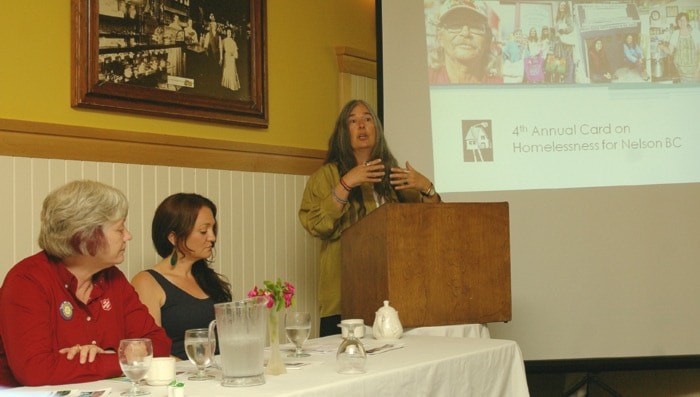Food banks and homeless shelters in Nelson were as busy as ever last year, according to statistics compiled in the most recent Report Card on Homelessness for Nelson, released Wednesday.
Produced by the Nelson Committee on Homelessness, the fourth annual report card analyzed 2011 data collected by organizations that provide services to our city’s most vulnerable.
It revealed a nine per cent decrease in the number of individuals accessing emergency shelter at Stepping Stones last year, when compared to 2010. But still the numbers are high: 207 individuals, ranging in age from 11 months old to 69 years old, seeking shelter for an average of 9.5 days.
“When you think of the size of our community, the number of people experiencing absolute homelessness is staggering,” said Katie Tabor, co-ordinator for NCOH, pointing out that hundreds more are at risk of homelessness and struggling to make ends meet.
According to the report, the average advertised rent for a one-bedroom apartment was $776, meaning the average person working 35 hours per week at minimum wage would be spending over half their gross income on rent.
An individual collecting social assistance receives only $375 per month for housing and $610 for other expenses. While the single person disability allowance is $906.
Tabor said if the government would increase those rates, it would go a long way to prevent homelessness.
“These rates are clearly not enough for people to meet their most basic needs of food and shelter,” Tabor said.
Last year, 68 per cent of people accessing Stepping Stones were collecting social assistance or disability allowance. Fifteen per cent were working, but not earning enough to afford for a stable home.
“Behind each of these statistics there’s an individual and a story,” Tabor stressed. “Homelessness in Nelson is really invisible, because we don’t see people sleeping on the street here. More often they’re pitching a tent in the woods or sleeping in the park, and going to the shelter when things get really tough.”
Food bank use steady
Nelson’s two food banks reached record high use in 2010 and remained steady in 2011 with 18,306 people visiting the two local facilities to pick up groceries.
On average, the Salvation Army distributed groceries to 400 individuals weekly and the Food Cupboard’s twice weekly program has 1,000 visits per month.
“To our surprise, we’ve been seeing more seniors and young people who are working [accessing the food bank],” said Major Yvonne Burrows of the Salvation Army.
The Our Daily Bread hot lunch program served 11,700 meals in 2011 and the Salvation Army’s breakfast program — just introduced last month — has already gained popularity.
“I have moms who come in and bring their children in for breakfast before they take them to school,” Burrows said. “It’s harsh to know families are struggling with such a basic function.”
Burrows said there’s no indication that the demand will decrease anytime soon.
Burrows said. “It’s harsh to know families are struggling with such a basic function.”
Burrows said there’s no indication that the demand will decrease anytime soon.
Transient population not to blame
Committee on Homelessness co-chair Phyllis Nash said there’s a common misconception that the bulk of the homeless people in Nelson are transients passing through.
“From our surveys, 95 per cent of the people we talk to are local folk,” Nash said. “A lot of young people that we think are transient are not. They’re people from within the Kootenays that move to Nelson because it’s the city and they think this is where they’re going to find work and housing, and they get here and there isn’t anything and they’re stuck with nowhere to go.”
Major Burrows agreed. She said the Salvation Army doesn’t provide food bank groceries to travellers, though they’re welcome to drop in at a hot food program.
“It’s a very small percentage of transient people using our services, almost an insignificant amount,” Burrows said.
Klee Hunter, affordable housing manager for Nelson CARES society, agreed. She said Stepping Stones usually turns away travellers, but will occasionally give them a bed if they’re in really rough shape.
“If they’re soaking wet and battered, we’ll let them stay. But they’re limited to three nights [at the shelter]” Hunter said. “We really just encourage them to move on. We have enough local people to take care of.”
Some successes
While the report card’s statistics show little change in the overall rate of local homelessness, there are individual success stories.
Nelson has 488 affordable housing units spread throughout the city, run by a handful of organizations. While there are growing wait lists for all the affordable units, there are also people using these programs to transition into longterm housing.
Hunter recalled one young man with a persistent mental illness who had been homeless all of his adult life. He found housing for the first time in one of the four supported housing units at Ward Street Place reserved people with severe mental health issues.
By staying in one of these special units, rather than one of the other 33 units in Ward Street Place, the man had access to a support worker visiting him twice daily to ensure he was taking his medications and remaining active.
“He got the help he needed, and was able to enter into the same type of rental agreement you or I would, for the first time in his life,” he said.
Nash said that’s just one of the many anecdotal successes she’s heard.
“There is progress being made,” Nash said. “I think the situation would be a whole lot worse if it weren’t for the social programs we have here.”
The full Report Card on Homelessness for Nelson will be available on the Nelson Cares website, nelsoncares.ca.
